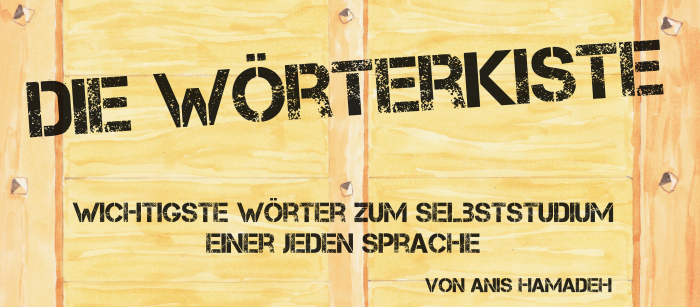| Struktur und Ausblick
Unten sieht man die Grundstruktur der Wörterkiste in zwölf Abschnitten: Es beginnt mit den wichtigsten kleinen Wörtern wie Orts- und Zeitangaben (hier, jetzt etc.), Präpositionen und Zahlen. Dann folgen zwei Abschnitte über das Leben, Fühlen und die Biologie inklusive der Medizin, denn der Inhalt ist (möglichst) von Konkret zu Abstrakt angeordnet. Abschnitt 4 betrifft den Alltag im Haus, gefolgt vom Alltag draußen inklusive Natur, Wetter und Geografie. Dann wird es abstrakter mit Denken, Messen und Bauen sowie den Wissenschaften. Erst danach kommen Sprache und Kommunikation. Abschnitt 9 markiert den Übergang zu gesellschaftlichen Themen mit Recht und Militär, Kunst, Sport und schließlich Besitz.
Vorteile der Wörterkiste sind neben den oben genannten, dass man Bedeutungsfelder und Listen systematisch finden und studieren kann. Dass meist ein zweites Wort dabeisteht, erleichtert den Merkprozess. Zudem kann man sich einzelne Listen oder Teilbereiche vornehmen und damit Beispielsätze bilden und Ähnliches, was eine Verwendungsmöglichkeit darstellt. Außerdem kann man Zusatzinformationen integrieren, wie oben bei der Herkunft türkischer Wörter gesehen. Mit den gestaffelten Versionen kann man klein anfangen und sich z.B. eine halbe Stunde lang mit den sechs Seiten beschäftigen, zur Vergegenwärtigung, bevor man spazierengeht und dabei versucht, ohne Hilfsmittel im Kopf Sätze zu bilden. Oder man speichert sich eine Arbeitskopie ab, aus der man jede Woche alle Wörter ausstreicht, die man inzwischen hinreichend kennt. An der Excel-Tabelle ist besonders cool, dass man auf einen Blick die Wörter für „Löwe“ usw. in vielen Sprachen nebeneinander sieht.
Zu den Haken gehört, dass die Wörterkiste bestimmt anders wäre, wenn ich sie im Original auf Englisch konzipiert hätte, denn jede Sprache hat ihre semantischen Eigenarten. Auch lassen sich in dieser Übersicht wichtige Elemente nicht abbilden, wie das Genus (maskulin, feminin, neutrum) oder unregelmäßige Plurale. Fast alles, was mit Grammatik zu tun hat, muss draußen bleiben. Darüber hinaus ist die Anordnung nach Kapiteln und Themen immer subjektiv, denn man kann die wichtigsten Wörter einer Sprache nicht logisch linear gliedern. Es gibt in jedem Fall gute Argumente für andere, alternative Anordnungen.
Wie es mit der Wörterkiste weitergeht, ist noch nicht klar. Inzwischen ist die Sache so weit ausgereift, dass ich sie zumindest in Teilen zugänglich machen möchte, denn ich arbeite nicht für die Schublade. Da es schwer ist, einen Verlag zu finden, und noch schwerer, Geld damit zu verdienen, steht die Alternative im Raum, die Wörterkiste einfach hier zu posten, z.B. eine 1300er-Gesamtversion mit zehn Sprachen als Ecxel-Datei. Bislang gibt es als Ecxel-Datei nur die Vollversion ... Ja, ich glaube, das mache ich. Wahrscheinlich 2024.
PS 16.10.2023: Mauricio Carvalho in Brasilien hat eine sehr ähnliche Idee gehabt, mit mehr Wörtern und mehr Sprachen. Ein Drittel seiner großen Excel-Tabelle steht frei online. Auf seinem YouTube-Kanal MOPC Languages erklärt er sein Projekt Intutionary.
|
Structure and Prospect
Below you can see the basic structure of the word box in twelve sections: It starts with the most important small words of place and time (here, now etc.), prepositions and numbers. Then follow two sections about living, feeling and biology including medicine, because the content is arranged (as much as possible) from concrete to abstract. Section 4 is about everyday life in the home, followed by everyday life outside including nature, weather, and geography. Then it becomes more abstract with thinking, measuring and building as well as the sciences. Only after that come language and communication. Section 9 marks the transition to social topics with law and the military, art, sports, and finally possessions.
Advantages of the word box, next to the ones already mentioned, are that one can systematically find and study semantic fields and lists. The fact that there is usually a second word to back the first one up makes the memorization process easier. In addition, you can take individual lists or subsections and use them to form example sentences and the like, which is one possible use. Furthermore, one can integrate additional information, as seen above with the origin of Turkish words. With the staggered versions one can begin small and occupy oneself e.g. for half an hour with the six pages, for recollection, before one goes for a walk and tries to form sentences without aids in the head. Or you can save a working copy, from which you cross out each week all the words that you meanwhile know sufficiently. What's particularly cool about the Excel spreadsheet is that you can see at a glance the words for "lion" etc. in many languages side by side.
One of the catches is that the word box would certainly be different if I had originally designed it in English, because each language has its semantic idiosyncrasies. Also, important elements cannot be represented in this overview, such as the genus (masculine, feminine, neuter) or irregular plurals. Almost everything that has to do with grammar has to be left out. Furthermore, the arrangement by chapters and topics is always subjective, because one cannot logically organize the most important words of a language in a linear way. Whatever you decide for, there are good arguments for other, alternative arrangements.
It is not yet clear what will happen with the word box. By now, it has matured to the point where I would like to make it accessible, at least in parts, because I don't work for the drawer. Since it is hard to find a publisher, and even harder to make money with it, the alternative is to simply post the Wörterkiste here, e.g. a 1300 complete version with ten languages as an Ecxel file. So far there is only the full version as ecxel file ... Yes, I think I will do that. Probably in 2024.
PS 16.10.2023: Mauricio Carvalho in Brazil came up with a very similar idea, with more words and more languages. One third of his large Excel spreadsheet is available online for free. On his YouTube channel MOPC Languages he explains his project Intutionary. |






